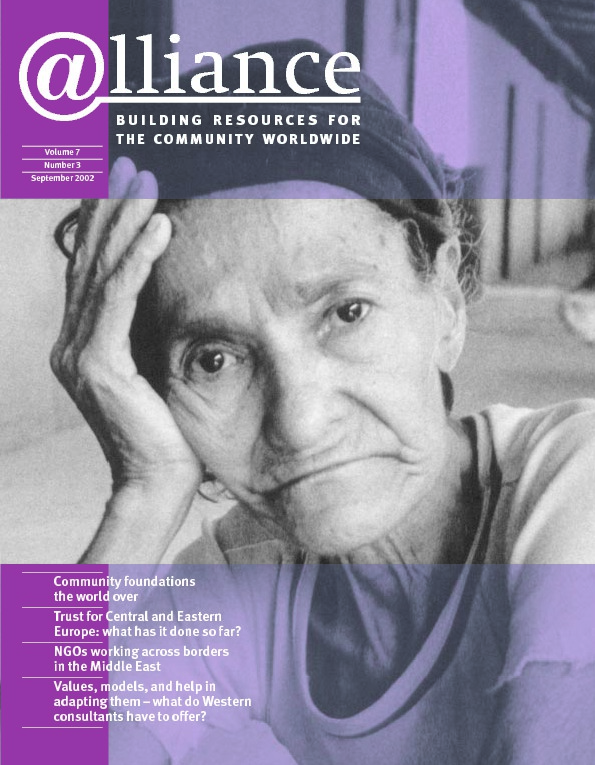‘Everyone can be a philanthropist, everyone can help to form a powerful foundation and give significant funds to the community.’[1] This novel notion lay behind Frederick Harris Goff’s brilliant idea of creating a community foundation in the United States through which anyone, even people of limited means, could give money to the community. In recent years, the idea has spread all around the globe. The question is whether it is universally applicable or whether it will have to be modified by the cultural conditions of each society.
In Mexico the community foundation idea has been gaining ground rapidly in recent years. It started with the creation of the Oaxaca Community Foundation in December 1996. A successful arrangement between local philanthropists and external agencies[2] helped to establish an initial endowment fund. Since then, community foundations have been established in several communities in Mexico. This has been facilitated by a relatively friendly legal framework that encourages families and local companies to contribute to the endowment funds.
In contrast to Mexico, in Brazil the concept of a community foundation as described above is unknown. Because of the paternalistic view of philanthropy in Brazil, still based on the charity model, an endowment fund is considered a barrier that prevents the philanthropist having full control over the organization’s resources and grantmaking. Nor does the legal framework in Brazil encourage the creation of local funds. As a result, setting up a community foundation requiring an endowment could prevent local philanthropists getting involved.
Promoting community philanthropy in Brazil
IDIS’s strategy in Brazil was not to start by promoting community foundations but by valuing community philanthropy. This strategy is the kernel of IDIS’s CPO (Community Philanthropy Organization) Programme to promote the idea in nine communities in Brazil.
Each CPO is an independent NGO designed to promote and foster a culture of giving to support local development. Each CPO takes on the role of an information centre on local philanthropy, including grantors and grantees; works as a permanent forum for establishing priorities and promoting causes; provides training for board members and staff of local organizations; and provides technical assistance to donors and grantees. The need to pursue results and impact is stressed, as is the importance of evaluation and dissemination of results.
The establishment of CPOs in Brazil is timely. There is a change of attitude on the part of government and business leaders. In recent years governments have been showing a greater openness to the idea of decentralizing public activity from federal and state level to local level, and establishing some common basis for cooperation with citizen groups. The issue of corporate social responsibility has gained space on the agenda of private enterprises, and they too are becoming responsible participants in the lives of their communities.
The success of a CPO as a new kind of organization fostering local development rests on its capacity to understand the potential of local governance. Without the active participation of community leaders, donors and grantees in planning and managing the organization, the CPO is unlikely to succeed. Leaders are required who can motivate and engage people.
IDIS’s experience shows that a CPO needs to establish a way of operating that respects traditional forms of giving in a community. This could be gifts in kind, or a bingo, or volunteer work. Valuing what communities have is a good way of revealing local philantropists and helping them to see themselves as essential to their communities. They should be seen as local assets to be developed.
This very simple approach is the reason for the success of our programme. More than 200 givers have been attracted, and a significant number of traditional philanthropists are changing their way of operating. They are asking grantees questions, they are interested in results, they are looking for sustainable impact in the community. In fact, through their example, they are setting the stage for new philanthropists. Parents giving their children responsibility for evaluating their gifts, a ‘buddy system’ of consultancy between ‘old’ and ‘new’ philanthropists, local programmes for donors to visit projects and programmes – all these are good examples of how a CPO can take advantage of the existing culture of giving.
1 Council on Foundations (1990) Community Foundation Training Manual, page v.
2 The MacArthurFord, Rockfeller, Mott and Kellogg Foundations were involved, with the active participation of the International Youth Foundation and Synergos Institute.
Marcos Kisil is President of IDIS (Institute for Development of Social Investment), São Paulo, Brazil. He can be contacted at mkisil@idis.org.br


Comments (0)